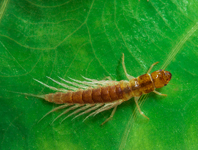Abstract
Amber has rarely been found in Africa and only a few samples with fossil inclusions are known (Kiefert et al. 2015). The most important fossiliferous find was reported from an outcrop at the north-western Plateau of Ethiopia a decade ago, revealing diverse inclusions of arthropods, plant remains, fungi and microorganisms (Schmidt et al. 2010). Initially, this amber was classified as originating from the mid-Cretaceous. Later studies, however, have raised questions about this determination and indicated a much younger age: Cenozoic, likely Miocene (Coty et al. 2016, Perrichot et al. 2016, Perrichot et al. 2018). The contradictory—and rather controversial discussed—new dating was based on spectroscopic analyses, revised palynological data and more comprehensive palaeoentomological results showing that insect fossils mostly belong to extant families and genera. In total, Schmidt et al. (2010) reported 22 insects from eight identified orders including two specimens of Thysanoptera: “an undetermined, wingless thrips“ (obviously a larva) and a female associated with Merothripidae. A more detailed analysis of these specimens is the objective of the present study; regarding the larva, only a rough classification and description is given, as fossil larvae cannot be definitely associated with adult specimens.
References
Bhatti, J.S. (2006) The classification of Terebrantia (Insecta) into families. Oriental Insects, 40, 339–375.
https://doi.org/10.1080/00305316.2006.10417487
Coty, D., Lebon, M. & Nel, A. (2016) When phylogeny meets geology and chemistry: doubts on the dating of Ethiopian amber. Annales de la Société Entomologique de France, 52 (3), 1–6.
https://doi.org/10.1080/00379271.2016.1230477
Grimaldi, D. & Engel, M.S. (2005) Evolution of the insects. Cambridge University Press, New York, 755 pp.
Hurd, P.D. Jr., Smith, R.F. & Durham, J.W. (1962) The fossiliferous amber of Chiapas, Mexico. Ciencia, 21 (3), 107–118.
Kiefert, L., Schollenbruch, K. & Wenxin, X. (2015) Natural green amber from Ethiopia. In: Abstract Volume of the 13th Swiss Geoscience Meeting, Basel, Switzerland, 2015, pp. 130–131.
Moritz, G. (2006) Thripse. In: Moritz, G. (Ed.), Pflanzensaftsaugende Insekten 1. Die Neue Brehm Bücherei. Bd. 663. Westarp Wissenschaften, Hohenwarsleben, pp. 1–384.
Mound, L.A. (1997) Biological diversity. In: Lewis, T. (Ed.), Thrips as crop pests. CAB International, Wallingford, pp. 1–740.
Mound, L.A., Heming, B.S. & Palmer, J.M. (1980) Phylogenetic relationships between the families of recent Thysanoptera (Insecta). Zoological Journal of the Linnean Society, 69, 111–141.
https://doi.org/10.1111/j.1096-3642.1980.tb01934.x
Mound, L.A. & O’Neill, K. (1974) Taxonomy of the Merothripidae, with ecological and phylogenetic considerations (Thysanoptera). Journal of Natural History, 8, 481–509.
https://doi.org/10.1080/00222937400770411
Nel, P., Peñalver, E., Azar, D., Hodebert, G. & Nel, A. (2010) Modern thrips families Thripidae and Phlaeothripidae in Early Cretaceous amber (Insecta: Thysanoptera). Annales de la Société Entomologique de France, 46 (1–2), 154–163.
https://doi.org/10.1080/00379271.2010.10697651
Perrichot, V., Boudinot, B., Cole, J., Dehaye-Prat, V., Ensault, J., Goldman, Y., Nohra, Y.A. & Schmidt, A.R. (2016) African fossiliferous amber: a review. In: Penny, D. & Ross, A.J. (Eds.), Abstracts of the 7th International Conference on Fossil Insects, Arthropods and Amber, Edinburgh, UK, 2016, pp. 41.
Perrichot, V., Boudinot, B., Chény, C., Cole, J., Jeanneau, L., Schmidt, A.R., Szwedo, J. & Wang, B. (2018) The age and paleobiota of Ethiopian amber revisited. In: Abstracts of The Fossil Week—5th International Paleontological Congress, Paris, France, 2018, pp. 23.
Priesner, H. (1924) Bernstein-Thysanopteren. Entomologische Mitteilungen, 13 (4–5), 130–151.
Priesner, H. (1929) Bernstein-Thysanopteren II. Bernsteinforschungen, 1, 111–138, pl. VIII.
Schmidt, A.R., Perrichot, V., Svojtka, M., Anderson, K.B., Belete, K.H., Bussert, R., Dörfelt, H., Jancke, S., Mohr, B., Mohrmann, E., Nascimbene, P.C., Nel, A., Nel, P., Ragazzi, E., Roghi, G., Saupe, E.E., Schmidt, K., Schneider, H., Selden, P.A. & Vávra, N. (2010) Cretaceous African life captured in amber. Proceedings of the National Academy of Sciences of the United States of America, 107 (16), 7329–7334.
https://doi.org/10.1073/pnas.1000948107
Shmakov, A.S. (2009) The oldest members of the families Aeolothripidae and Thripidae (Insecta: Thysanoptera) from the Lower Cretaceous of Transbaikalia. Paleontological Journal, 43 (4), 428–432.
https://doi.org/10.1134/S003103010904011X
Shmakov, A.S. & Perkovsky, E.E. (2009) Thrips (Thysanoptera, Insecta) from the Rovno amber, Eocene of Ukraine. Paleontological Journal, 43 (6), 669–674.
https://doi.org/10.1134/S0031030109060112
zur Strassen, R. (1973) Fossile Fransenflügler aus mesozoischem Bernstein des Libanon (Insecta: Thysanoptera). Stuttgarter Beiträge zur Naturkunde, Serie B (Geologie und Paläontologie), 256, 1–51.
ThripsWiki (2020) ThripsWiki—providing information on the world’s thrips: Merothripidae. Available from: http://thrips.info/wiki/Merothripidae (accessed 2 April 2020)
Ulitzka, M.R. (2015) Praemerothrips hoodi Priesner, 1929 and Merothrips balticus sp. nov.—Two new fossils of thrips from Baltic Tertiary amber (Thysanoptera: Merothripidae). Entomologische Zeitschrift, 125 (4), 213–216.
Ulitzka, M.R. (2017) Studies on thrips inclusions in subrecent Colombian copal (Thysanoptera). Entomologische Zeitschrift, 127 (3), 149–154.
Ulitzka, M.R. (2018) A first survey of Cretaceous thrips from Burmese amber including the establishment of a new family of Tubulifera (Insecta: Thysanoptera). Zootaxa, 4486 (4), 548–558.
https://doi.org/10.11646/zootaxa.4486.4.8
Ulitzka, M.R. & Mound, L.A. (2017) The fossil species Merothrips dietrichi (Schliephake) comb.n. redescribed and transferred from the genus Heterothrips (Thysanoptera). Zootaxa, 4231 (4), 573–576.
https://doi.org/10.11646/zootaxa.4231.4.7
Vance, T.C. (1974) Larvae of the Sericothripini (Thysanoptera: Thripidae) with reference to other larvae of the Terebrantia, of Illinois. Illinois Natural History Survey Bulletin, 31 (5), 141–208.
Vierbergen, G., Kucharczyk, H. & Kirk, W.D.J. (2010) A key to the second instar larvae of the Thripidae of the Western Palaearctic region (Thysanoptera). Tijdschrift Voor Entomologie, 153 (1), 99–160.
https://doi.org/10.1163/22119434-900000294


